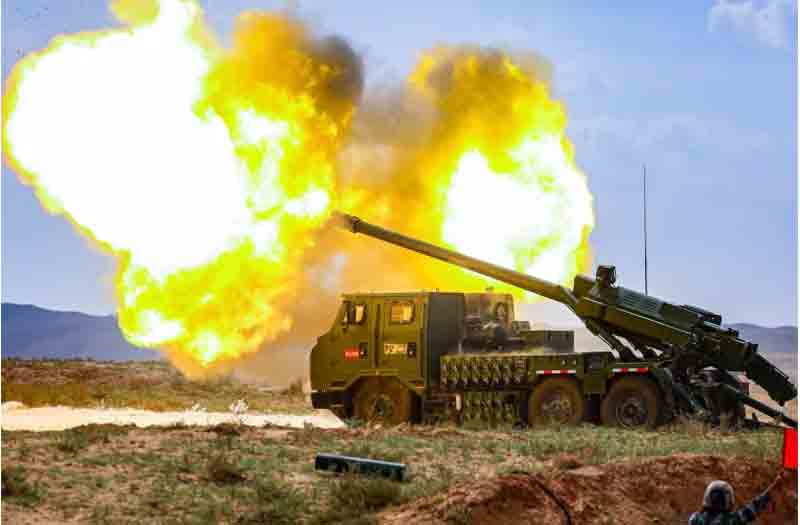In a significant enhancement of its artillery capabilities, the Pakistan Army has stationed numerous newly acquired SH-15 155mm self-propelled howitzers at key points along the Line of Control (LoC) with India, amid escalating regional tensions. According to local defense media, Pakistan has deployed around 80 SH-15 artillery systems to strengthen its forward positions, a strategy aimed at countering India’s increasing superiority in long-range precision fire.
The SH-15, produced by China’s defense giant NORINCO, provides the Pakistan Army with a mobile, rapid-response artillery platform capable of engaging targets up to 50 kilometers away, thereby enhancing the effectiveness and reach of its ground forces. The introduction of these advanced artillery systems significantly boosts Pakistan’s capacity for delivering powerful counter-battery and interdiction fire along one of the most heavily militarized borders globally.
In 2019, Islamabad signed a pivotal contract with NORINCO to acquire a total of 236 SH-15 155mm/52 caliber self-propelled howitzers, marking a strategic pivot towards Chinese-made, integrated ground combat systems. The first shipment of SH-15s arrived in Pakistan in January 2022, and the system was publicly showcased during the Pakistan Day military parade on March 23, 2022, underscoring its vital role in the nation’s artillery modernization initiatives.
By April 2023, a second batch of 56 SH-15 units had been delivered, significantly enhancing Pakistan’s ability to deploy mobile long-range fire capabilities across various operational theaters.
The SH-15 is an export variant of the Chinese PCL-181 system, mounted on a Shaanxi 6×6 armored truck chassis. This design merges mobility, protection, and firepower into a highly survivable platform tailored for rapid maneuver warfare. Equipped with a 52-caliber barrel, the SH-15 can fire standard NATO 155mm artillery rounds to distances over 53 kilometers when utilizing Extended Range Full Bore–Base Bleed (ERFB-BB) munitions, providing a significant stand-off strike capability. The system features a fully digital fire control system, complemented by satellite-guided GPS and inertial navigation technologies, allowing for quick target engagement with minimal setup time, which is crucial for effective shoot-and-scoot tactics that help avoid enemy counter-battery fire.
Its wheeled design offers the SH-15 enhanced strategic and operational mobility compared to conventional tracked howitzers, making it particularly effective for deployment in Pakistan’s diverse landscapes, ranging from the rugged Himalayas and the Thar Desert to intricate semi-urban combat zones.
Military experts view Pakistan’s acquisition of the SH-15 as a strategic response to India’s artillery force expansion, especially with the introduction of the South Korean K9 Vajra-T self-propelled howitzer and the domestically produced Dhanush gun. Notably, the SH-15’s compatibility with precision-guided munitions, including GPS-guided artillery shells, significantly boosts Pakistan’s capability to conduct high-precision strikes against key enemy targets such as command centers, logistics facilities, and troop concentrations.
The strategic ramifications of this capability are significant, considering the high density of military and civilian infrastructure on both sides of the Line of Control (LoC), where tensions could quickly escalate into a larger conflict.
The acquisition of the SH-15 not only highlights its technical capabilities but also emphasizes the strengthening defense relationship between China and Pakistan, which has evolved from fighter jets and submarines to include advanced land-based strike systems, further cementing Beijing’s position as Islamabad’s main strategic ally. This diversification illustrates Pakistan’s practical approach to lessen its reliance on Western arms suppliers, whose transactions are increasingly subject to political influences, sanctions, and technology restrictions in the current multipolar global landscape.
Presently, the SH-15 serves as a fundamental element of Pakistan’s developing artillery strategy, offering a mobile, adaptable, and lethal platform that can excel in both conventional warfare and cross-domain operations along its eastern and western borders.
Defense analysts assert that the deployment of the SH-15 significantly enhances Pakistan’s deterrent capabilities, especially amid rising instability in South Asia, driven by India’s aggressive border strategies and the precarious situation in Afghanistan.
The SH-15’s high mobility and rapid-firing features provide the Pakistan Army with enhanced tactical flexibility in shaping the battlefield, enabling quicker concentration of firepower and swift repositioning to evade counteractions.
The deployment of SH-15 units in close proximity to Lahore, just 50 kilometers from Amritsar in India, has caused significant concern among Indian military officials. They fear that key strategic locations could be targeted by accurate long-range strikes if conflict arises.
Importantly, the SH-15’s capability to launch GPS-guided munitions over a distance of 53 kilometers puts major Indian military bases, supply lines, and civilian facilities within striking distance, thereby fundamentally changing the operational strategies of the Indian Northern Command.
Discover more from Defence Talks | Defense News Hub, Military Updates, Security Insights
Subscribe to get the latest posts sent to your email.





